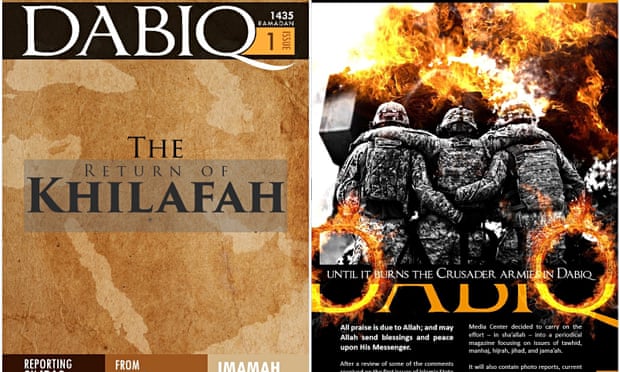Cubs and Pearls: A generational war, there is no end.
Dabiq is the sophisticated online magazine for Islamic State. What is Dabiq?

TheGuardian: Dabiq is a small, rather nondescript town in northern Syria, close by the border with Turkey. It’s more of a large village really, with just a few thousand inhabitants.
And it is of limited strategic interest. Not far south, in the sprawling city of Aleppo, where battle rages, Bashar al-Assad continues to drop his untargeted barrel bombs on its Sunni population, thus rallying more and more jihadis to the black flag. Yet it is Dabiq after which Islamic State (Isis) names its glossy recruiting magazine. For this is the place where the world will come to an end.
Like Judaism and Christianity – and strongly influenced by them – Islam has a powerful eschatological strain. It anticipates the end of the world and a final historical confrontation between good and evil, after which human life is set to be miraculously transformed. And according to one reading of Islamic tradition (hadith), the place where this final malahim (apocalypse) will happen is – of all places – Dabiq. This is where the Muslim and Christian armies will finally face each other and the Crusaders will be destroyed. And this is why Dabiq is the name on the lips of Isis recruiting sergeants.
It is worth noting that Isis is extremely selective in its use of hadith. For instance, other parts of the tradition have it that Jesus, dressed in yellow robes, will return east of Damascus and will join forces with the Islamic messiah, the Mahdi, in a battle against the false messiah, the Dajjal. After the death of the Mahdi, it is the Muslim Jesus who will rule the Earth. This hadith is less useful to Isis, though its leader, Abu Bakr al-Baghdadi, looks to many observers to be trying to style himself as the Mahdi.
The Battle of Marj Dābiq (Arabic: مرج دابق, meaning “the meadow of Dābiq”; Turkish: Mercidabık Muharebesi) was a decisive military clash in Middle Eastern history, fought on 24 August 1516, near the town of Dabiq, 44 km north of Aleppo, Syria.[1] The battle was part of the Ottoman–Mamluk War (1516–17) between the Ottoman Empire and the Mamluk Sultanate, which ended ultimately in an Ottoman victory, the conquest of most of the Middle East by the Ottoman Empire, and the end of the Mamluk Sultanate. The Ottoman Empire’s victory in this battle gave it control of the entire region of Syria.

The Ottoman–Mamluk War of 1516–1517 was the second major conflict between the Egypt-based Mamluk Sultanate and the Ottoman Empire, which led to the fall of the Mamluk Sultanate and the incorporation of the Levant, Egypt and the Arabian Peninsula as provinces of the Ottoman Empire.[1] The war transformed the Ottoman Empire from a realm at the margins of the Islamic world, mainly located in Anatolia and the Balkans, to a huge empire encompassing the traditional lands of Islam, including the cities of Mecca, Cairo, Damascus and Aleppo. It continued to be ruled however from Constantinople
